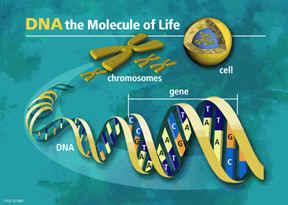From the probably hundreds of times: “Science has proven evolution is fact.” It’s like a strange Darwinian chant that emanates from atheist blogs and secular universities. Too bad (for them) it’s not true.
In fact, refuting evolution doesn’t require complicated equations or lab experiments—though those do the job, too. Just remember the two fundamental flaws we can use to show evolution to be, well, not even scientifically viable.
Where’d You Get Your Information, Bub?
 Everything that makes up your body requires genetic information. You’ve got hands and feet because your genes code for it. The same is true for any creature—dogs, camels, you name it.
Everything that makes up your body requires genetic information. You’ve got hands and feet because your genes code for it. The same is true for any creature—dogs, camels, you name it.
The genetic information in humans varies from the information in animals, plants, and so on. Seems obvious, so why point it out? Because for animal kind A to somehow “presto-change-o” into animal kind B, the information’s got to change. A fish doesn’t just morph into an amphibian without something changing in the genes. It would have to gain some new information.
Here’s the clincher: when we use operational science—the kind involving observable, repeatable, testable results—we have never observed, repeated, or been able to test animal kind A turning into animal kind B—at all. Sure, there’s some genetic “do-si-do” going on through mutations and gene drift, but there’s no way fish are going to sprout hair and opposable thumbs. Just in case you think by “no way” we mean there’s still a chance, there’s not—none, zilch, nada, not going to happen. What if we add billions of years and cool artistic renderings? Still no.
Original Recipe
That first point is devastating enough. But here’s how evolution gets buried even more.
Continue reading


 “Suppose the first American astronauts to walk on the moon had brought back, along with moon rocks, an oblong black box that appeared from the outside to have been crafted by machines. Suppose further that, when opened, the box contained the workings of a camera: it had parts that functioned like the lens, shutter, and other components of a camera. Obviously, such an object would excite enormous and justifiable curiosity about how it came to be. It is hard to imagine any skeptic’s gaining respect by maintaining that the principle of sufficient reason did not apply to such an object. Equally absurd would be efforts to explain the box in terms of chance, natural forces. The very nature of the object pointed to its having been made by an intelligent being. The human mind properly balks at the suggestion that a cameralike object was produced by chance, natural forces. But then how much more should we reject claims that something far more intricate, such as the human eye, resulted from anything less than an intelligent being.” Ronald Nash, Faith and Reason (Grand Rapids: Zondervan, 1994, p. 135.)
“Suppose the first American astronauts to walk on the moon had brought back, along with moon rocks, an oblong black box that appeared from the outside to have been crafted by machines. Suppose further that, when opened, the box contained the workings of a camera: it had parts that functioned like the lens, shutter, and other components of a camera. Obviously, such an object would excite enormous and justifiable curiosity about how it came to be. It is hard to imagine any skeptic’s gaining respect by maintaining that the principle of sufficient reason did not apply to such an object. Equally absurd would be efforts to explain the box in terms of chance, natural forces. The very nature of the object pointed to its having been made by an intelligent being. The human mind properly balks at the suggestion that a cameralike object was produced by chance, natural forces. But then how much more should we reject claims that something far more intricate, such as the human eye, resulted from anything less than an intelligent being.” Ronald Nash, Faith and Reason (Grand Rapids: Zondervan, 1994, p. 135.)